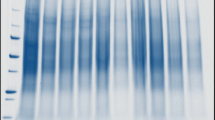Abstract
The proteome of rumen epithelial tissue was analysed by SDS-PAGE coupled with LC–MS/MS. 813 non-redundant proteins were identified of which 7.4 % featured membrane-spanning domains and 15.4 % harboured a signal peptide. According to the gene ontology annotation, the most abundant proteins exhibited binding activities related to their molecular functions, were proteins of cellular components or belonged to various metabolic processes. A predominant group of canonical pathways in the rumen epithelial tissue was identified using the IPA software. The GeLC–MS/MS approach was used to characterise the entire protein expression repertoire in rumen tissue, providing a more detailed understanding of the important biological processes in the rumen.

Similar content being viewed by others
References
Abdoun K, Stumpff F, Martens H (2006) Ammonia and urea transport across the rumen epithelium: a review. Anim Health Res Rev 7:43–59
Bendixen E, Danielsen M, Hollung K, Gianazza E, Miller I (2011) Farm animal proteomics–a review. J Proteomics 74:282–293
Bondzio A, Gabler C, Badewien-Rentzsch B, Schulze P, Martens H, Einspanier R (2011) Identification of differentially expressed proteins in ruminal epithelium in response to a concentrate-supplemented diet. Am J Physiol Gastrointest Liver Physiol 301:G260–268
Fu-Jun L, Hai-Yan W, Jian-Yuan L (2012) A new analysis of testicular proteins through integrative bioinformatics. Mol Biol Rep 39:3965–3970
Gerling IC, Singh S, Lenchik NI, Marshall DR, Wu J (2006) New data analysis and mining approaches identify unique proteome and transcriptome markers of susceptibility to autoimmune diabetes. Mol Cell Proteomics 5:293–305
Klopfleisch R, Gruber AD (2012) Transcriptome and proteome research in veterinary science: what is possible and what questions can be asked? ScientificWorldJournal 2012:254962
Krishnan S, Gaspari M, Della Corte A, Bianchi P, Crescente M, Cerletti C, Torella D, Indolfi C, de Gaetano G, Donati MB, Rotilio D, Cuda G (2011) OFFgel-based multidimensional LC–MS/MS approach to the cataloguing of the human platelet proteome for an interactomic profile. Electrophoresis 32:686–695
Krogh A, Larsson B, von Heijne G, Sonnhammer EL (2001) Predicting transmembrane protein topology with a hidden Markov model: application to complete genomes. J Mol Biol 305:567–580
Nie L, Wu G, Culley DE, Scholten JC, Zhang W (2007) Integrative analysis of transcriptomic and proteomic data: challenges, solutions and applications. Crit Rev Biotechnol 27:63–75
Peddinti D, Memili E, Burgess SC (2010) Proteomics-based systems biology modeling of bovine germinal vesicle stage oocyte and cumulus cell interaction. PLoS ONE 5:e11240
Petersen TN, Brunak S, von Heijne G, Nielsen H (2011) SignalP 4.0: discriminating signal peptides from transmembrane regions. Nat Methods 8:785–786
Pisanu S, Ghisaura S, Pagnozzi D, Biosa G, Tanca A, Roggio T, Uzzau S, Addis MF (2011) The sheep milk fat globule membrane proteome. J Proteomics 74:350–358
Schirle M, Heurtier MA, Kuster B (2003) Profiling core proteomes of human cell lines by one-dimensional PAGE and liquid chromatography-tandem mass spectrometry. Mol Cell Proteomics 2:1297–1305
Sehested J, Diernaes L, Moller PD, Skadhauge E (1999) Transport of butyrate across the isolated bovine rumen epithelium–interaction with sodium, chloride and bicarbonate. Comp Biochem Physiol A Mol Integr Physiol 123:399–408
Steele MA, Croom J, Kahler M, Alzahal O, Hook SE, Plaizier K, McBride BW (2011) Bovine rumen epithelium undergoes rapid structural adaptations during grain-induced subacute ruminal acidosis. Am J Physiol Regul Integr Comp Physiol 300:R1515–1523
Taniguchi M, Penner GB, Beauchemin KA, Oba M, Guan LL (2010) Comparative analysis of gene expression profiles in ruminal tissue from Holstein dairy cows fed high or low concentrate diets. Comp Biochem Physiol Part D Genomics Proteomics 5:274–279
Torres-Garcia W, Zhang W, Runger GC, Johnson RH, Meldrum DR (2009) Integrative analysis of transcriptomic and proteomic data of Desulfovibrio vulgaris: a non-linear model to predict abundance of undetected proteins. Bioinformatics 25:1905–1914
Wang Z, Hill S, Luther JM, Hachey DL, Schey KL (2012) Proteomic analysis of urine exosomes by multidimensional protein identification technology (MudPIT). Proteomics 12:329–338
Yousuf MA, Mi-ichi F, Nakada-Tsukui K, Nozaki T (2010) Localization and targeting of an unusual pyridine nucleotide transhydrogenase in Entamoeba histolytica. Eukaryot Cell 9:926–933
Zhou L, Zhao SZ, Koh SK, Chen L, Vaz C, Tanavde V, Li XR, Beuerman RW (2012) In-depth analysis of the human tear proteome. J Proteomics 75:3877–3885
Acknowledgments
The project was supported by the National Key Basic Research Program of China (Project No. 2011CB100805).
Conflict of interest
The authors have declared no conflict of interest.
Author information
Authors and Affiliations
Corresponding author
Electronic supplementary material
Below is the link to the electronic supplementary material.
Rights and permissions
About this article
Cite this article
Yang, Y., Wang, J., Yuan, T. et al. Proteome profile of bovine ruminal epithelial tissue based on GeLC–MS/MS. Biotechnol Lett 35, 1831–1838 (2013). https://doi.org/10.1007/s10529-013-1291-6
Received:
Accepted:
Published:
Issue Date:
DOI: https://doi.org/10.1007/s10529-013-1291-6




